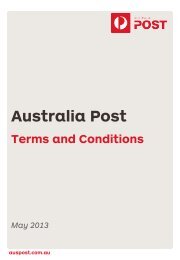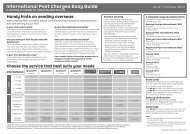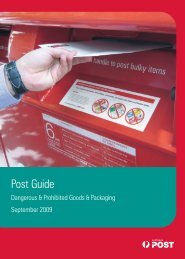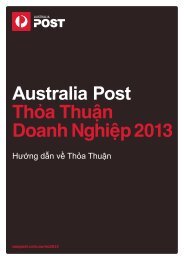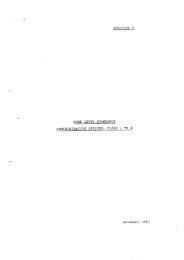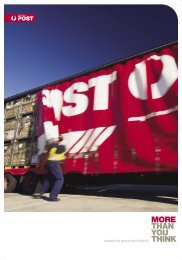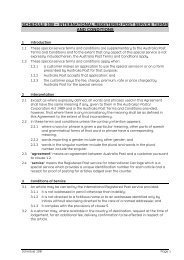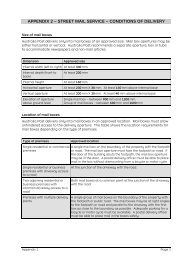LET'S GET ACTIVE! - Australia Post Shop
LET'S GET ACTIVE! - Australia Post Shop
LET'S GET ACTIVE! - Australia Post Shop
Create successful ePaper yourself
Turn your PDF publications into a flip-book with our unique Google optimized e-Paper software.
TALKING STAMPS<br />
WITH RICHARD BRECKON<br />
<strong>Australia</strong>’s early<br />
commemorative stamps<br />
As readers might be aware, the<br />
New South Wales Centennial<br />
stamps of 1888–90 were the<br />
world’s fi rst commemorative<br />
issue. In 1897, New South Wales<br />
and Victoria issued the world’s<br />
fi rst charity stamps. (Stamps sold<br />
at a premium price to benefi t<br />
a charity.) Notwithstanding<br />
the innovations, no further<br />
commemorative stamps were<br />
issued between 1901 and 1927.<br />
The reason for this involved<br />
the introduction of a ban on<br />
commemorative stamps being<br />
used in the international mail<br />
system by the Universal <strong>Post</strong>al<br />
Union (UPU). As far as <strong>Australia</strong><br />
was concerned, the ban precluded<br />
commemorative stamps being<br />
issued, even for use in the<br />
domestic post.<br />
The UPU lifted the ban in 1922,<br />
allowing commemorative stamps<br />
to be issued freely. Five years<br />
later, the opening of Federal<br />
Parliament House in Canberra<br />
was the obvious occasion for the<br />
fi rst <strong>Australia</strong>n Commonwealth<br />
commemorative issue.<br />
The Canberra stamp was the<br />
subject of a public design<br />
competition. The winning entry<br />
(selected anonymously by<br />
the judging committee) was<br />
submitted by Ronald Harrison, the<br />
chief artist at the Note Printing<br />
Branch, Melbourne. Had there<br />
been no competition Harrison<br />
would have been instructed to<br />
prepare the stamp design in his<br />
offi cial capacity!<br />
As well as establishing a<br />
precedent for commemorative<br />
issues, the Canberra stamp was<br />
issued uniformly throughout<br />
<strong>Australia</strong> on 9 May 1927 (the<br />
date of the opening of Parliament<br />
House, Canberra), and from this<br />
point fi xing a uniform stamp issue<br />
date became the normal practice.<br />
The next commemorative issue<br />
was a 3d Kookaburra stamp for<br />
the 1928 Melbourne International<br />
Philatelic Exhibition. The stamp<br />
was produced in a miniature<br />
sheet of four, this being only the<br />
fourth miniature sheet produced<br />
anywhere in the world.<br />
In 1929 a stamp was issued<br />
for the 150th anniversary of<br />
European settlement in Western<br />
<strong>Australia</strong>. By this stage, the<br />
postal authorities recognised the<br />
importance of commemorative<br />
stamps and, overcoming a<br />
previous reluctance, they<br />
solicited ideas for further<br />
commemorative issues.<br />
The Charles Sturt Centenary<br />
stamps of 1930 resulted from a<br />
suggestion by the Royal Victorian<br />
Historical Society.<br />
Charles Kingsford Smith’s aviation<br />
career was honoured with<br />
three stamps in 1931, which<br />
set the pattern for subsequent<br />
commemorative issues: a 2d<br />
stamp for basic letter postage<br />
within <strong>Australia</strong> and to British<br />
Empire countries; a 3d stamp for<br />
basic letter postage to foreign<br />
countries; and one higher<br />
denomination stamp for other<br />
postal purposes.<br />
The issue of three stamps for the<br />
opening of the Sydney Harbour<br />
Bridge in 1932 included the<br />
highest denomination of the early<br />
<strong>Australia</strong>n commemoratives. The<br />
fi ve shilling Bridge stamp has<br />
been called the “fi ve bob bridge”<br />
by generations of collectors.<br />
After a gap of two and a half<br />
years the next commemorative<br />
issue marked the centenary of<br />
European settlement in Victoria<br />
(1934). The common design to<br />
the three stamps features an<br />
Aboriginal man facing a modern<br />
Melbourne skyline. A few months<br />
later, a three-stamp set marked<br />
the death centenary of<br />
John Macarthur, regarded as<br />
the wool industry’s founder.<br />
auspost.com.au/stamps<br />
During 1935 two commemorative<br />
issues appeared. The fi rst marked<br />
the 20th anniversary of the<br />
ANZAC landing at Gallipoli, the<br />
stamp design featuring London’s<br />
Cenotaph, in accordance with<br />
a desire for a symbolic, nonmilitaristic<br />
approach. The second<br />
honoured the silver jubilee of<br />
King George V, the stamp design<br />
showing the King riding his<br />
horse “ANZAC”, a gift from the<br />
<strong>Australia</strong>n government.<br />
In 1936 Tasmania was joined to<br />
the mainland by a submarine<br />
telephone cable, completing<br />
a link-up of all states to the<br />
national telephone network.<br />
This occasion was recognised<br />
by commemorative stamps.<br />
Later that year, the centenary of<br />
European settlement in South<br />
<strong>Australia</strong> was commemorated by<br />
stamps featuring “then and now”<br />
scenes of Adelaide.<br />
The 150th anniversary of<br />
European settlement in <strong>Australia</strong><br />
was commemorated by three<br />
stamps issued in 1937, ahead<br />
of <strong>Australia</strong> Day 1938 to help<br />
generate advance publicity.<br />
Oddly, no commemorative<br />
stamps were issued in 1937<br />
to mark the coronation of King<br />
George VI.<br />
The next commemorative issue,<br />
in 1940, marked the departure<br />
of the <strong>Australia</strong>n Imperial Force<br />
for overseas service. The stamp<br />
design recognised the three<br />
branches of the armed forces,<br />
together with the nursing<br />
service. This was the only<br />
commemorative issue between<br />
1938 and 1944; World War II<br />
precluded the stamps being<br />
issued regularly. Following the<br />
war commemorative stamps<br />
returned to their regular (and an<br />
increased) frequency.<br />
September–October 2009 | no. 300 | stamp bulletin australia | 19




